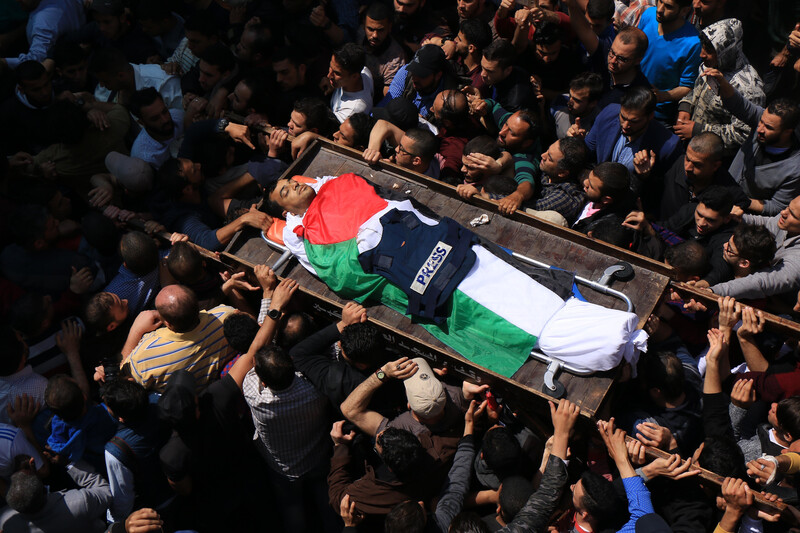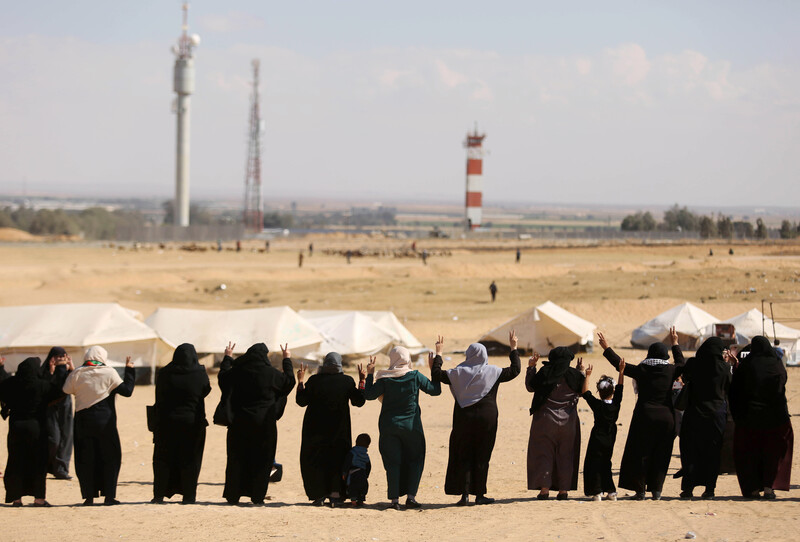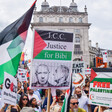Rights and Accountability 12 April 2018

Palestinians evacuate Abdullah Muhammad Shahri after he was shot in the chest by Israeli soldiers during a protest at the boundary with Israel in Khan Younis, southern Gaza Strip, on 12 April. Shahri died from his wounds later that day.
APA imagesThe legs of two Palestinians were amputated on Wednesday after Israel refused to allow them to leave the blockaded Gaza Strip for treatment.
Human rights groups had appealed to the Israeli authorities to allow for the transfer of Yusif Karnaz, 20, and Muhammad al-Ajouri, 17, to a hospital in the occupied West Bank for surgery that would save their limbs.
The youths were shot during the launch of the Great March of Return protests along the Gaza-Israel boundary on 30 March.
But COGAT – the bureaucratic arm of Israel’s military occupation that postures as a humanitiarian body – denied their requests for permission to travel for specialized surgery unavailable in Gaza.
Israel admitted that it refused the request as a form of punishment for protesting.
“On the surface, the petitioners’ condition ostensibly fulfills the medical criterion for receiving a permit but the authorized officials decided not to grant their requests,” the state said in response to a court petition submitted on behalf of the injured youths, the Israeli daily Haaretz reported.
“The main consideration for the refusal stems from the fact that their medical condition is a function of their participation in the disturbances,” the state added.
One of the injured youths, Yousif Karnaz, “is in danger of losing his second leg if he does not receive urgent medical attention in the West Bank,” according to the human rights group Adalah.
“The willful act of denying urgent medical care, in these circumstances, may constitute cruel, inhuman and degrading treatment and/or torture under the UN Convention Against Torture, ratified by Israel,” stated Adalah, which petitioned the Israeli government on behalf of the youths along with the Gaza-based Al Mezan Center for Human Rights.
The Palestinian Campaign for the Academic and Cultural Boycott of Israel highlighted the case of the two youths whose legs were amputated in its efforts to relocate part of the prestigious Giro d’Italia cycling race from Jerusalem:
Israel’s killing and injuring unarmed demonstrators has spurred boycott initiatives while its attempts to spin the narrative have been largely unsuccessful. On Thursday the International Federation of Journalists accused Israel of “fabricating lies to justify murder” in the case of Yaser Murtaja, a cameraman who was fatally wounded while covering Great March of Return protests in southern Gaza last Friday.Israeli defense minister Avigdor Lieberman has doubled down on his comments justifying the killing of a journalist who was wearing a bulletproof vest and helmet both marked with the word “PRESS” when he was hit.
On Saturday, Lieberman claimed that Murtaja was operating a drone when he was shot – an assertion even Israel’s military has denied.
On Tuesday, Lieberman told reporters that Murtaja was on Hamas’ payroll since 2011, and a high-ranking officer in its military wing who used drones to collect intelligence on Israeli forces, Haaretz reported.
“Lieberman provided no evidence to support his claims,” Haaretz stated.
Instead it was revealed in recent days that Murtaja’s company, Ain Media, was granted funds from the US government aid agency USAID last month.Murtaja was killed two days before he was set to start working with the Norwegian Refugee Council, a major humanitarian group, according to Haaretz.
The Norwegian aid group’s Karl Schembri termed Lieberman and Gerald Steinberg, founder of the anti-Palestinian group NGO Monitor, “slanderers and peddlers of lies” regarding Murtaja:
On Wednesday it was reported that Murtaja had been detained and beaten by Hamas security forces while filming the demolition of a home near the Gaza-Israel boundary in 2015.Murtaja was hospitalized as a result of his injuries and his documentation was seized.

Mourners carry the body of Yaser Murtaja during his Gaza City funeral on 7 April, one day after he was fatally wounded by Israeli occupation forces.
APA imagesMurtaja’s last footage, showing the Great March of Return protest encampment and Israel’s violence against it, was published this week:
Murtaja is an exceptional case of a Palestinian killed by Israel receiving widespread international attention. Murtaja had worked with high-profile Chinese artist Ai Weiwei for his Human Flow documentary on global migration and filmed the Gaza scenes for the feature-length experimental film Ouroboros by Palestinian director Basma Alsharif.“I remember when we did Ouroboros, there was a scene in a house, which is considered the longest one-shot scene in Palestinian cinema,” producer Mohanad Yacoubi told Screen Daily.
“It took him two days to do the correct mise-en-scene. He kept on repeating it until he mastered the movement. It’s an amazing scene.”
As Israel came under mounting criticism over its use of lethal force against unarmed protesters – and was warned by the International Criminal Court that its leaders might face trial – video emerged this week showing soldiers cheering after shooting an unarmed demonstrator near the Gaza boundary fence.
The Israeli military’s preliminary inquiry into its own soldiers’ behavior found that the sniper who shot the Palestinian seen falling to the ground in the video had “acted appropriately and only fired after all other actions taken by the soldiers did not succeed in preventing the man from approaching the fence,” Haaretz reported.
The inquiry however faulted the behavior of the soldiers who filmed the incident and distributed the footage.
Several Israeli leaders condoned the soldiers’ actions, with education minister Naftali Bennett stating “I prefer a whooping soldier to a grieving father.”
Public security minister Gilad Erdan stated that he was “unable to comprehend what isn’t okay in the video.”
Erdan asserted that anyone disturbed by the video “should direct their energies towards being appalled by what’s been going on in Syria and exert pressure on the United States and Western states to act militarily and raise this issue publicly.”
Defense minister Lieberman stated that “The sniper deserves a promotion, whereas the cameraman deserves a demotion … At the end of the day, the army, snipers and soldiers – they’re the best of us, and the IDF is the most moral army.”
A military officer who recently served in a unit that enforces Israel’s military occupation in Gaza told the Israeli outlet Ynet that a Palestinian “does not necessarily have to be armed or trying to cut or climb over the fence” to justify the army opening fire.
Reuters reported that the Palestinian man seen shot in the video, dating from 22 December, was 28-year-old Tamer Abu Daqqa.
Abu Daqqa told Reuters that he was between 100 and 150 meters from the fence and was trying to help injured protesters when he was shot.
“I was standing with other people when I was hit in my leg, I was not throwing stones or anything,” he said.
“They shot me and later they laughed at me. They cursed my mother. I can sue them for that.”

Palestinian women protest to demand the right to return to their homeland at the boundary with Israel in Rafah, southern Gaza Strip, 10 April.
APA imagesMore than two dozen unarmed civilians have been killed by Israeli soldiers in Gaza since the six-week Great March of Return protest began on 30 March.
Israel is still trying to present the protests as a Hamas-led terrorist threat against Israelis, though not a single Israeli has been killed or wounded in connection to the protests:
The Israeli military killed a Palestinian fighter in Gaza late Wednesday in an airstrike.The military claimed that it attacked Hamas sites in response to the discovery of an explosive device along the boundary earlier in the day.
On Thursday, Israeli forces shot in the chest and killed Abdullah Muhammad Shahri, 28, during protests east of Khan Younis in southern Gaza.The Palestinian BDS National Committee which steers the global boycott, divestment and sanctions campaign against Israeli impunity on Thursday called for a two-way arms embargo as “the most effective response to Israel’s ongoing massacre.”
The group added: “This means working to end all weapons sales and purchases to and from Israel, and ending military or police partnerships with the Israeli state.”
Tags
- Yusif Karnaz
- Muhammad al-Ajouri
- COGAT
- Adalah
- PACBI
- International Federation of Journalists
- Avigdor Lieberman
- Yaser Murtaja
- Ain Media
- Norwegian Refugee Council
- Karl Schembri
- Great March of Return
- Ai Weiwei
- Ouroboros (film)
- Mohanad Yacoubi
- Naftali Bennett
- Gilad Erdan
- Tamer Abu Daqqa
- Hamas
- Abdullah Muhammad Shahri






Comments
There will never be justice
Permalink Lowell Harris replied on
There will never be justice and peace between the Palestinians and Israel until Netanyahu is out of office.
Justice in Palestine
Permalink Stefano R. Baldari replied on
The above comment is extremely naive. Whoever the Israeli Prime Minister is does not make one whit of a difference. Illegitimate Israel is a racist, apartheid, imperialist, genocidal, Nazi-like state. There will only be justice when there is one democratic state and all citizens are considered, under law, equal.